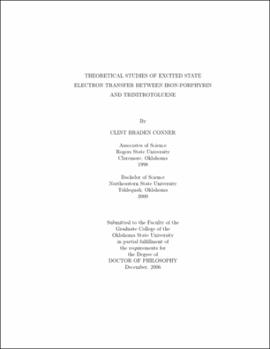| dc.contributor.advisor | Wilson, Timothy M. | |
| dc.contributor.author | Conner, Clint Braden | |
| dc.date.accessioned | 2013-11-26T08:26:30Z | |
| dc.date.available | 2013-11-26T08:26:30Z | |
| dc.date.issued | 2006-12 | |
| dc.identifier.uri | https://hdl.handle.net/11244/6880 | |
| dc.description.abstract | Scope and Method of Study: The purpose of this study was to find and better understand the degradation of trinitrotoluene (TNT) by way of the photocatalyst iron-tetraphenyl-porphyrin-sulfonate (FeTPPS) by looking at a possible pathway in which the process might proceed. We studied a smaller iron complex iron-porphyrin (FeP), due to the complexity of the larger molecule in terms of size, to determine if future calculations involving FeTPPS could be handled more effectively using the much smaller FeP. We used various levels of theory in order to determine the viability of the process studied, and made use of our computer cluster to carry out the necessary calculations. | |
| dc.description.abstract | Findings and Conclusions: Using FeTPPS as a photocatalyst has been shown to degrade or deactivate TNT experimentally. The analysis of our FeP system has given us the theoretical excited state spectrum which is in good agreement with that of the experimental spectrum. We calculated the different multiplets of the iron complexes and found near degeneracies amongst the ground states. This analysis shows a mixing of the multiplets in the system and that the excitation of the iron complexes utilizes both the triplet and the quintet states. With the good agreement between the theoretical results and the experimental results we found that using the smaller iron complex FeP, we can account for the same behavior as that of the larger iron complex FeTPPS. We then analyzed the thermodynamics of the process to determine the if the degradation process would run. We did find that the pathway studied is certainly a possibility in which the process can take. Therefore, we showed that we can use the smaller iron complex to model a similar but larger iron complex, and that the process is thermodynamically favored with the pathway we studied. | |
| dc.format | application/pdf | |
| dc.language | en_US | |
| dc.rights | Copyright is held by the author who has granted the Oklahoma State University Library the non-exclusive right to share this material in its institutional repository. Contact Digital Library Services at lib-dls@okstate.edu or 405-744-9161 for the permission policy on the use, reproduction or distribution of this material. | |
| dc.title | Theoretical studies of excited state electron transfer between iron-porphyrin and trinitrotoluene | |
| dc.contributor.committeeMember | Harmon, Harold J. | |
| dc.contributor.committeeMember | Summy, Gil | |
| dc.contributor.committeeMember | Materer, Nick | |
| osu.filename | Conner_okstate_0664D_2003.pdf | |
| osu.accesstype | Open Access | |
| dc.type.genre | Dissertation | |
| dc.type.material | Text | |
| thesis.degree.discipline | Physics | |
| thesis.degree.grantor | Oklahoma State University | |
